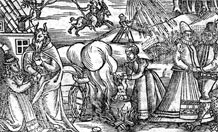
The breadth of Isobel’s testimony is reflected in most of the activities depicted in the compendium of witch-practices in the frontispiece to German bishop Peter Binsfield’s Tractat von Bekanntnuss der Zauberer und Hexen (1592).
New research on Highland witch
The witchcraft confessions of Isobel Gowdie in Scotland, 1662, are widely celebrated as the most extraordinary on record in Britain.
The first full length examination of the confessions and the life and character of the woman behind them has been published by a University of Exeter historian.
Over a six-week period local ministers and other inquisitors elicited four long and very detailed confessions from Isobel. These included 27 magical charms designed for a wide variety of purposes, from destroying crops to gaining success at market.
The new book ‘The Visions of Isobel Gowdie: Magic, Witchcraft and Dark Shamanism in Seventeenth-Century Scotland’ by research fellow Emma Wilby, includes full transcriptions of the original trial documents, which she uncovered during her research, and which had been deemed lost for nearly 200 years. The research separates Isobel’s voice from that of her interrogators, identifies the beliefs and experiences that informed her testimony and analyses why her confessions differ so much from those of others accused of witchcraft in that period.
Wilby said, ‘Witchcraft confessions offer a window into the religious and magical worldviews of the peasant community – worldviews that are normally hidden from us. They reveal that in 17th century Scotland peasants inhabited a quasi-polytheistic universe. They petitioned God and Christ for spiritual aid, but also fairies, saints, spirits of the dead, heroes of myth and legend and even, on occasion, the Devil. In this world, God had to fight for his spot in the limelight just like everyone else.’
The book also emphasises that we must look at witchcraft confessions in the light of the fact that in 17th century Scotland, it was considered honourable to respond to an injury by revenge. She added, ‘Many peasants would have limited access to legal protection from people higher up the social chain. It is logical that they should have turned to a magical practitioner or witch for magical charms as a means of taking some form of control and retribution.’
The book argues that Gowdie’s confessions are highly unusual because although they contain the conventional witch-confession details like pacts with the Devil, the witches’ sabbath and harmful magic, they also contain vivid and colourful folkloric detail which would not have been put into her mouth by the interrogators. These include accounts of flying through the air shooting elf arrows with the fairy host and feasting with the King and Queen of the Fairies.
Wilby said, ‘My research suggests that Isobel’s confessions contain so much vividly-described folkloric detail because she was an oral performer or village bard, while her interrogators, for their part, were particularly curious and attentive. As a result, her interrogation sessions were unusually creative.’
Wilby’s book has been shortlisted for the Katharine Briggs Folklore Award 2010. The award was established to encourage the study of folklore, to help improve the standard of folklore publications in Britain and Ireland.
Date: 30 October 2010
